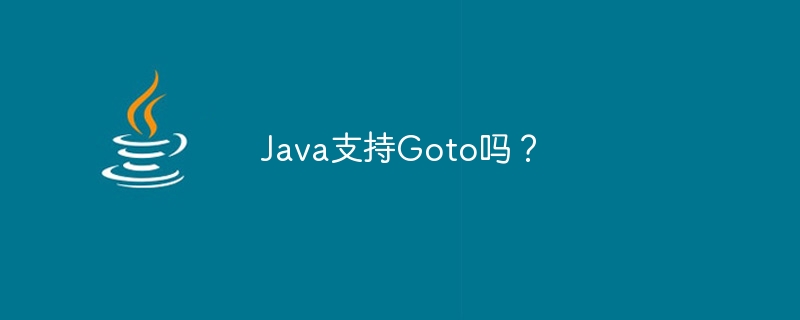Java支援Goto嗎?
- 王林轉載
- 2023-09-05 23:33:071126瀏覽

Java 以其一致性和多功能性而聞名。 Java 提供了幾種控制流主要方法。 Java 的字源結構缺乏控制流程說明,如「goto」語句所示。在這一部分中,我們將了解為什麼 Java 沒有 goto 函數、它的一些選項,以及如何使用它們來實現類似的目標。
文法
首先,我們來看看 Java 的語言結構。 goto 解釋可讓您根據名稱自由交換代碼部分。 Goto 在 C 和 C 中產生複雜的控制流,但程式碼通常不可讀且毫無價值。
label: {
// Code section 1
if (condition) {
// Code section 2
if (anotherCondition) {
// Code section 3
break label;
} else {
// Code section 4
if (yetAnotherCondition) {
// Code section 5
if (finalCondition) {
// Code section 6
}
}
}
}
// Code section 7
}
語法解釋
Java 的作者省略了 goto 表達,因為它會使程式碼變得混亂並且難以理解。他們青睞結構化控制流,以獲得更清晰的程式碼和更少的錯誤。
演算法
Java 中用於管理控制流程的逐步演算法 -
入口點- 程式的執行將從已選取的入口點開始,該入口點可以是主方法或另一個入口點。
按順序執行 - 程式碼以連續的方式逐行運行,除非遇到控制流程解釋,在這種情況下執行會跳到下列斷言程式。
建立迴圈的語句循環語句(包括 for、while 和 do-while 語句)允許重複程式碼區塊,直到滿足特定條件。
方法
即使 Java 沒有 goto,開發人員也找到了建立類似功能的方法。
方法 1:標籤和條件語句
說明
標籤可以標記程式碼段,條件表達式可以根據條件控制執行。 Goto 缺乏控制力和可讀性。
範例
public class GotoExample {
public static void main(String[] args) {
GotoExample program = new GotoExample();
program.execute();
}
private void execute() {
label: {
System.out.println("Executing Code Section 1");
// Code section 1
if (condition) {
System.out.println("Executing Code Section 2");
// Code section 2
if (anotherCondition) {
System.out.println("Executing Code Section 3");
// Code section 3
break label;
} else {
System.out.println("Executing Code Section 4");
// Code section 4
if (yetAnotherCondition) {
System.out.println("Executing Code Section 5");
// Code section 5
if (finalCondition) {
System.out.println("Executing Code Section 6");
// Code section 6
}
}
}
}
System.out.println("Executing Code Section 7");
// Code section 7
}
}
private boolean condition = true;
private boolean anotherCondition = true;
private boolean yetAnotherCondition = true;
private boolean finalCondition = true;
}
輸出
Executing Code Section 1 Executing Code Section 2 Executing Code Section 3
說明
為了示範執行情況,我們將 System.out.println() 語句插入到每個程式碼部分。這使您可以追蹤執行情況並根據情況查看正在運行的內容。控制中心顯示代碼執行訊息。
方法2 用方法封裝
透過將程式碼封裝在方法中來建構Java控制流。透過將軟體分解為可管理的部分,方法呼叫讓我們可以瀏覽它。
範例
public class GotoExample {
public static void main(String[] args) {
GotoExample program = new GotoExample();
program.execute();
}
private void execute() {
section1();
if (condition()) {
section2();
if (anotherCondition()) {
section3();
return;
} else {
section4();
if (yetAnotherCondition()) {
section5();
if (finalCondition()) {
section6();
}
}
}
}
section7();
}
private void section1() {
System.out.println("Executing Code Section 1");
// Code section 1
}
private void section2() {
System.out.println("Executing Code Section 2");
// Code section 2
}
private void section3() {
System.out.println("Executing Code Section 3");
// Code section 3
}
private void section4() {
System.out.println("Executing Code Section 4");
// Code section 4
}
private void section5() {
System.out.println("Executing Code Section 5");
// Code section 5
}
private void section6() {
System.out.println("Executing Code Section 6");
// Code section 6
}
private void section7() {
System.out.println("Executing Code Section 7");
// Code section 7
}
private boolean condition() {
// Define the condition logic
return true;
}
private boolean anotherCondition() {
// Define the anotherCondition logic
return true;
}
private boolean yetAnotherCondition() {
// Define the yetAnotherCondition logic
return true;
}
private boolean finalCondition() {
// Define the finalCondition logic
return true;
}
}
輸出
Executing Code Section 1 Executing Code Section 2 Executing Code Section 3
說明
我加入了section3()、section4()、section5()、section6()和section7()方法。 Condition、anotherCondition、yetAnotherCondition 和 FinalCondition 被它們的過程所取代。這些方法適合您。
方法 3 狀態機
狀態機管理複雜的控制流程。狀態機以數學方式表示轉換。狀態機組織控制流程。
範例
enum State {
STATE_1, STATE_2, STATE_3, STATE_4, STATE_5, STATE_6, STATE_7
}
public class GotoExample {
public static void main(String[] args) {
GotoExample program = new GotoExample();
program.execute();
}
private void execute() {
State currentState = State.STATE_1;
while (currentState != State.STATE_7) {
switch (currentState) {
case STATE_1:
section1();
currentState = State.STATE_2;
break;
case STATE_2:
if (condition()) {
section2();
currentState = State.STATE_3;
} else {
currentState = State.STATE_4;
}
break;
// Define other states and transitions
}
}
}
private void section1() {
System.out.println("Executing Code Section 1");
// Code section 1
}
private void section2() {
System.out.println("Executing Code Section 2");
// Code section 2
}
// Define other section methods and states
private boolean condition() {
// Define the condition logic
return true;
}
}
輸出
Executing Code Section 1 Executing Code Section 2
說明
我們將條件推理加入到condition() 的技術規格中。如果可能,請變更條件()的策略群組。
方法4異常處理
Java 中的例外處理或具有已檢查、未檢查和錯誤的 Java 異常,以及 try、catch、 throw、 throws 和 finally 關鍵字的範例和用法。
範例
public class GotoExample {
public static void main(String[] args) {
try {
section1();
if (condition()) {
section2();
if (anotherCondition()) {
section3();
throw new GotoException();
} else {
section4();
if (yetAnotherCondition()) {
section5();
if (finalCondition()) {
section6();
throw new GotoException();
}
}
}
}
section7();
} catch (GotoException e) {
// Handle the exception to continue execution
// or perform any necessary operations
}
}
private static void section1() {
System.out.println("Executing Code Section 1");
// Code section 1
}
private static void section2() {
System.out.println("Executing Code Section 2");
// Code section 2
}
private static void section3() {
System.out.println("Executing Code Section 3");
// Code section 3
}
private static void section4() {
System.out.println("Executing Code Section 4");
// Code section 4
}
private static void section5() {
System.out.println("Executing Code Section 5");
// Code section 5
}
private static void section6() {
System.out.println("Executing Code Section 6");
// Code section 6
}
private static void section7() {
System.out.println("Executing Code Section 7");
// Code section 7
}
private static boolean condition() {
// Define the condition logic
return true;
}
private static boolean anotherCondition() {
// Define the anotherCondition logic
return true;
}
private static boolean yetAnotherCondition() {
// Define the yetAnotherCondition logic
return true;
}
private static boolean finalCondition() {
// Define the finalCondition logic
return true;
}
}
class GotoException extends Exception {
// Custom exception class to simulate the "goto" behavior
}
輸出
Executing Code Section 1 Executing Code Section 2 Executing Code Section 3
說明
方法 4 複製 goto 宣告來處理例外狀況。為了「跳」到程式碼,我們發出 GotoException。嘗試使用 GotoException 控制執行。
結論
即使沒有 goto 表達,Java 的有序控制流方法也能運作。標記、有限的關節、狀態機和有序程式設計範例可協助工程師編寫無錯誤、有效率的程式碼。要創建值得信賴、易於理解的 Java 程序,您必須接受這些可能性並遵循最佳實踐。
以上是Java支援Goto嗎?的詳細內容。更多資訊請關注PHP中文網其他相關文章!

